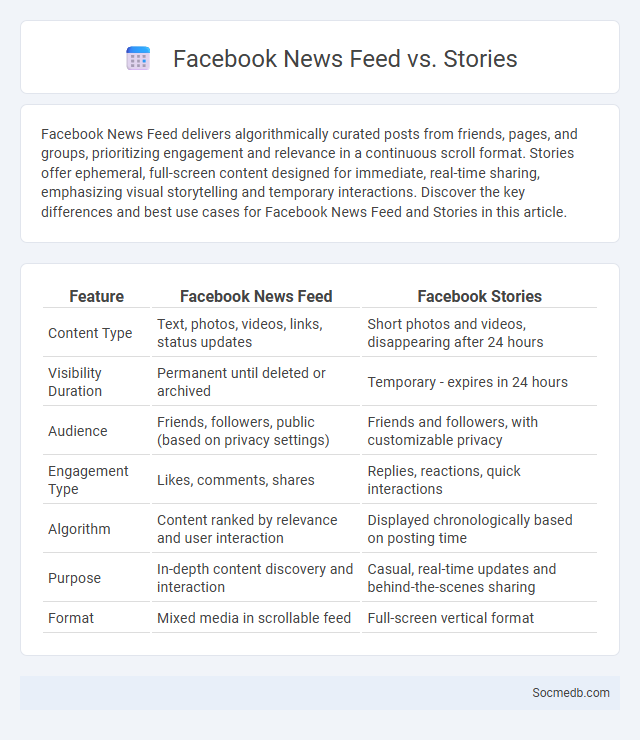
Photo illustration: Facebook News Feed vs Stories
Facebook News Feed delivers algorithmically curated posts from friends, pages, and groups, prioritizing engagement and relevance in a continuous scroll format. Stories offer ephemeral, full-screen content designed for immediate, real-time sharing, emphasizing visual storytelling and temporary interactions. Discover the key differences and best use cases for Facebook News Feed and Stories in this article.
Table of Comparison
| Feature | Facebook News Feed | Facebook Stories |
|---|---|---|
| Content Type | Text, photos, videos, links, status updates | Short photos and videos, disappearing after 24 hours |
| Visibility Duration | Permanent until deleted or archived | Temporary - expires in 24 hours |
| Audience | Friends, followers, public (based on privacy settings) | Friends and followers, with customizable privacy |
| Engagement Type | Likes, comments, shares | Replies, reactions, quick interactions |
| Algorithm | Content ranked by relevance and user interaction | Displayed chronologically based on posting time |
| Purpose | In-depth content discovery and interaction | Casual, real-time updates and behind-the-scenes sharing |
| Format | Mixed media in scrollable feed | Full-screen vertical format |
Understanding Facebook News Feed
Facebook News Feed organizes posts using an algorithm that prioritizes content based on user interactions, post popularity, and timeliness, ensuring personalized and relevant updates. It considers factors like user engagement, post type, and relationship strength to rank content, enhancing user experience and platform engagement. Understanding these elements helps businesses and creators optimize their content strategy to reach wider audiences effectively.
What Are Facebook Stories?
Facebook Stories are short photo or video collections that disappear after 24 hours, designed for sharing real-time moments with friends and followers. These stories appear at the top of the Facebook app and allow users to add stickers, text, and effects to enhance engagement. With over 500 million daily active users on Facebook Stories, this feature boosts interactive communication and content visibility.
Comparing News Feed and Stories: Core Differences
News Feeds on social media platforms prioritize chronological or algorithmically curated posts that users can scroll through continuously, offering a broad overview of updates from friends, pages, and groups. Stories feature ephemeral content, lasting typically 24 hours, designed for more immediate, personal, and engaging snapshots with interactive elements like polls or stickers. The fundamental difference lies in News Feeds fostering long-term engagement through permanent posts, while Stories emphasize real-time, fleeting interactions promoted by visual storytelling.
User Engagement: Stories vs News Feed
User engagement on social media varies significantly between Stories and News Feed formats, with Stories driving more immediate, interactive responses through features like polls, questions, and swipe-ups, resulting in higher completion rates and stronger personal connection. News Feed content, while offering broader reach and detailed posts, generally sees slower interactions due to algorithmic timing and content saturation. Optimizing your content strategy by leveraging Stories for real-time engagement and News Feed for in-depth updates maximizes audience interaction and retention.
Content Visibility on News Feed and Stories
Content visibility on social media's News Feed and Stories depends heavily on the platform's algorithm, which prioritizes user engagement, recency, and relevance. Optimizing your content with high-quality visuals, interactive elements, and timely posts increases the likelihood that Your audience will see and interact with your updates. Regular analysis of engagement metrics enables adjustments that enhance visibility and keep your content competitive in crowded feeds.
Algorithm Impacts: Stories vs News Feed
Social media algorithms prioritize content differently between Stories and News Feed, shaping Your engagement experience. Stories are designed to highlight recent, ephemeral content, often from close connections, promoting immediacy and authenticity. News Feeds use complex ranking systems that emphasize relevance, popularity, and personal interests to deliver a curated stream of posts over time.
Best Content Types for Stories and News Feed
Video content drives the highest engagement rates on social media stories and news feeds, with short-form clips capturing audience attention quickly. Carousel posts effectively showcase multiple products or messages in one sequence, boosting interaction and retention. User-generated content and authentic testimonials foster trust and increase click-through rates, enhancing overall campaign performance.
Business Benefits: Stories Versus News Feed
Social media Stories offer businesses higher engagement rates by providing ephemeral, authentic content that encourages immediate interaction, contrasting with News Feed posts that often suffer from algorithmic visibility limits. Stories' full-screen, vertical format enhances brand storytelling through immersive visuals and interactive features like polls and swipe-ups, driving direct conversions and customer engagement. Utilizing Stories alongside News Feed posts creates a diversified content strategy that maximizes reach, boosts brand loyalty, and improves overall marketing ROI.
Audience Preferences: Stories or News Feed?
Understanding your audience preferences is crucial for maximizing engagement on social media platforms. Stories offer fleeting, interactive content that appeals to users seeking quick, behind-the-scenes glimpses, while News Feed posts provide more permanent, detailed updates that encourage deeper connections and sharing. Tailoring your content strategy by analyzing user behavior and platform algorithms ensures your message resonates effectively with your target audience.
Choosing the Right Feature for Your Strategy
Selecting the right social media features is crucial for maximizing your engagement and reach. Features like Stories, Reels, live streaming, and polls each serve different purposes and audience interactions, allowing you to tailor content for specific goals. To optimize your strategy, analyze which formats resonate best with your target audience and align with your brand's voice.
 socmedb.com
socmedb.com